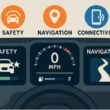Installing emergency light bars on vehicles is crucial for first responders, maintenance crews, and other authorized personnel who must ensure visibility and safety during emergencies. But what’s the correct way to install an emergency light bar on your vehicle?
The basic installation involves securely mounting the light bar to your vehicle’s roof using manufacturer-provided brackets, connecting the wiring to your vehicle’s electrical system through a switch panel, and ensuring all connections are weatherproofed.
However, before you proceed with the installation, you must understand that there are specific legal requirements and restrictions about who can use emergency light bars and what colors are permitted in your jurisdiction. Continuing to read will help you ensure your installation is legally compliant and executed adequately for optimal performance and safety.
What Are The Legal Requirements For Emergency Light Bars?
Different jurisdictions have specific laws regarding who can use emergency light bars and what colors are permitted. Generally, red and blue lights are restricted to law enforcement and emergency vehicles only. Amber/yellow lights are typically allowed for civilian use on maintenance, construction, or utility vehicles.
Before installing any emergency light bar, check your local and state regulations. Most areas require special permits or licenses to operate vehicles with emergency lights. Violations can result in significant fines and legal consequences.
What Are The Different Types Of Emergency Light Bar Mounts?
Emergency light bars can be mounted in several ways, depending on your vehicle type and needs. Permanent mounts require drilling into the vehicle’s roof and provide the most secure installation. Magnetic mounts offer temporary placement without vehicle modification but are only suitable for speeds under 65 mph. Vacuum mounts provide a middle-ground solution with semi-permanent installation.
How Do I Wire An Emergency Light Bar Safely?
Proper wiring is crucial for both safety and functionality. Start by running the power cable from the light bar through a weatherproof grommet into the vehicle’s interior. Install a dedicated switch panel in an easily accessible location near the dashboard. Use an appropriate gauge wire and fuse to handle the light bar’s power requirements.
Always connect the power cable directly to the battery with an inline fuse for protection. Ground the system correctly to prevent electrical issues. If you’re not confident with electrical work, consider professional installation to avoid potential hazards and ensure proper functionality.
What Is The Best Placement For An Emergency Light Bar?
The optimal placement of your emergency light bar is crucial for maximum visibility and effectiveness. The ideal position is centered on the highest point of your vehicle’s roof, typically 6-12 inches from the front edge. This placement ensures 360-degree visibility and minimizes reflection off the hood that could impair the driver’s vision.
Alternative positions include the front grille, rear deck, or side panels for vehicles where roof mounting isn’t possible, such as some utility trucks or specialized equipment. However, these positions may reduce overall visibility and effectiveness compared to roof mounting.
How Do I Maintain My Emergency Light Bar?
Regular maintenance ensures your emergency light bar remains functional and reliable when needed. Inspect all mounting hardware monthly to ensure brackets haven’t loosened due to vibration. Clean the light bar’s lenses regularly with a non-abrasive cleaner to maintain optimal brightness and visibility.
Check electrical connections every three months for signs of corrosion or damage, particularly in areas exposed to weather. Replace any cracked or yellowed lens covers promptly, as they can significantly reduce light output. Also, all light patterns should be tested periodically to ensure all LEDs function correctly and replace any failed modules according to manufacturer specifications.
Keep detailed maintenance records and know your light bar’s warranty period. Most quality LED light bars have a lifespan of 50,000 hours or more, but environmental factors and usage patterns can affect longevity.
Time To Get Started
Before beginning your emergency light bar installation, take the crucial first step of checking your local regulations and obtaining any necessary permits for your specific use case. Contact your local Department of Motor Vehicles or law enforcement agency to verify the legal requirements for your intended application, as this will determine the type of light bar you can install and how you can use it.








